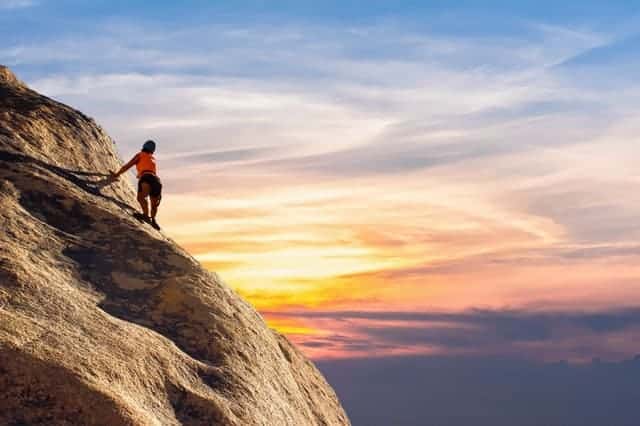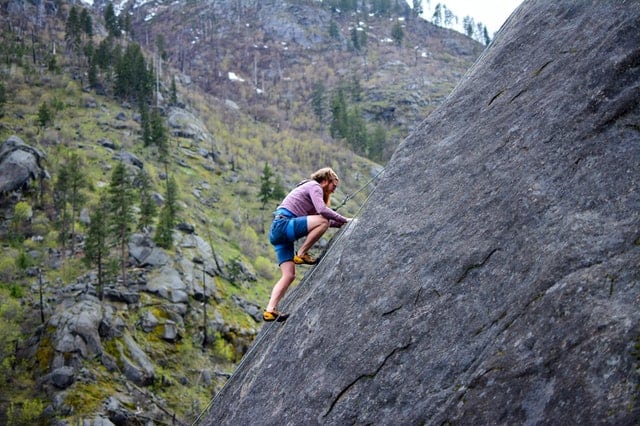A true rock climber’s body is often a thing of beauty. Rock climbing requires everything from strength to pull yourself up, the power to execute explosive movements, balance to stay upright, a stable core to boost your efficiency, and endurance to sustain yourself during longer climbs.
But, at the center of it all, a rock climber needs to have strong and stable shoulders.
A rock climber’s body is likely one of the most naturally aesthetic physiques, but that rock climber body won’t mean anything if you don’t have the shoulder health and strength to go climbing regularly.
Importance of Shoulder Strength for Climbers
Climbing demands a unique combination of strength, stability, and mobility, particularly in the shoulder muscles.
However, climbers often experience shoulder strain, fatigue, and even injuries if their shoulders aren’t properly trained and conditioned.
Climbers rely on the deltoids, rotator cuff muscles, trapezius, and lats to maintain control on challenging routes.
Weakness in any of these areas can increase the risk of shoulder injuries, which are common among climbers due to repetitive overhead and pulling movements.
Developing strong, stable shoulders can dramatically enhance your climbing endurance, improve technique, and help prevent injuries.
The shoulder exercises below are specifically designed to target the muscles and movement patterns essential for climbers
Best Shoulder Exercises for Rock Climbers

Here are the best exercises for your shoulders that you should be doing consistently if you are a rock climber:
1.) Scapular Pull-Ups
Overview: Scapular pull-ups help activate and strengthen the scapular muscles, which are critical for climbing. This exercise improves shoulder stability, allowing climbers to initiate pull-ups from a secure base.
How to Perform:
- Hang from a pull-up bar with an overhand grip, hands shoulder-width apart.
- Without bending your elbows, pull your shoulder blades down and together, lifting your body slightly.
- Hold for a second at the top, then release.
- Perform 2-3 sets of 10-12 repetitions.
Benefits: Scapular pull-ups activate the serratus anterior and lower trapezius muscles, which are essential for shoulder stability in climbing movements.
2.) Dumbbell Shoulder Press
Overview: The shoulder press strengthens the deltoids, which are essential for overhead movements in climbing. This exercise also activates the triceps and stabilizes the shoulder joint.
How to Perform:
- Hold a dumbbell in each hand at shoulder height with palms facing forward.
- Press the weights overhead until your arms are fully extended.
- Slowly lower the weights back to the starting position.
- Complete 3 sets of 8-10 repetitions.
Benefits: This exercise builds strength in the deltoids and promotes shoulder stability, critical for maneuvers that require extended reach.
3.) External Rotations with Resistance Bands
Overview: Strengthening the rotator cuff muscles is essential to prevent shoulder injuries in climbing. Resistance band external rotations are ideal for isolating and strengthening these muscles.
How to Perform:
- Attach a resistance band to a stable anchor at waist height.
- Stand with your side facing the anchor and hold the band in your outside hand.
- With your elbow bent at a 90-degree angle, rotate your arm outward, keeping your elbow close to your body.
- Return to the starting position.
- Perform 2-3 sets of 15 repetitions on each arm.
Benefits: External rotations help protect the rotator cuff by strengthening the infraspinatus and teres minor, essential muscles for shoulder stability in climbing.
4.) Face Pulls
Overview: Face pulls are excellent for activating the rear deltoids and upper back, which are often underdeveloped in climbers. They support shoulder health and contribute to balanced muscle development.
How to Perform:
- Attach a rope handle to a cable machine at face level.
- Grip the handles with both hands, thumbs pointing back.
- Pull the handles towards your face, flaring your elbows out.
- Squeeze your shoulder blades together at the end of the movement.
- Perform 3 sets of 12-15 repetitions.
Benefits: Face pulls strengthen the rear deltoids, trapezius, and rhomboids, improving shoulder stability and preventing forward shoulder posture.
5.) Kettlebell Windmill
Overview: The kettlebell windmill is a powerful exercise for developing shoulder stability, core strength, and hip mobility, all essential for climbers. This movement targets the shoulders, obliques, and hips, helping climbers maintain stability and control during twisting and overhead movements.
It is also one of the best kettlebell ab exercises and will help you get a rock climber’s body!
How to Perform:
- Hold a kettlebell in one hand and press it overhead, locking out your elbow.
- Position your feet slightly wider than shoulder-width apart, with your toes pointing away from the kettlebell.
- Keeping your arm extended overhead, shift your hips back and slowly lower your torso toward the ground, reaching your opposite hand toward your front foot.
- Keep your gaze on the kettlebell and maintain a straight line through your torso and lifted arm.
- Return to the starting position by engaging your core and driving through your hips.
- Perform 2-3 sets of 6-8 repetitions per side.
Benefits: The kettlebell windmill strengthens the shoulder stabilizers, particularly the rotator cuff, while enhancing core strength and hip mobility. This exercise promotes better balance and stability, helping climbers with lateral and overhead movements, especially in dynamic positions on the wall.
6.) Y-T-W Raises
Overview: The Y-T-W raise targets the shoulder stabilizers and is beneficial for climbers who rely on shoulder stability for control and precision. These are some of the best shoulder exercises at home because you don’t need weight.
How to Perform:
- Lie face down on an incline bench or stability ball.
- Extend your arms to make a “Y” shape, squeezing your shoulder blades together.
- Move your arms to make a “T” shape, then finally to a “W” shape.
- Repeat the sequence for 2-3 sets of 10-12 repetitions.
Benefits: This exercise activates the rhomboids, lower traps, and rotator cuff muscles, enhancing shoulder stability and coordination.
7.) Kettlebell Dead Bug
Overview: The kettlebell dead bug is a core and shoulder stability exercise that improves overall body control and coordination, essential for climbers. This exercise engages the core while challenging the shoulder stabilizers, promoting a solid foundation for stability during complex climbing movements.
How to Perform:
- Lie on your back with a kettlebell held with both hands above your chest, arms fully extended.
- Lift your legs so your knees are bent at 90 degrees and your shins are parallel to the floor.
- Slowly lower one leg toward the ground, keeping your core engaged and your back pressed into the floor, while maintaining the kettlebell in the overhead position.
- Bring your leg back to the starting position and switch sides, lowering the other leg.
- Perform 2-3 sets of 10-12 repetitions per side.
Benefits: The kettlebell dead bug strengthens the core and improves shoulder stability, both crucial for climbers needing control and endurance during challenging movements. This exercise enhances core engagement, helping to protect the lower back and improve overall balance and stability on the wall.
8.) Dumbbell Around the World
Overview: The dumbbell around the world exercise exercise targets the entire shoulder complex, focusing on mobility, control, and endurance. This movement helps strengthen the deltoids, rotator cuff muscles, and upper traps, which are essential for climbers to maintain stability and shoulder health.
How to Perform:
- Stand with a dumbbell in each hand, arms resting at your sides with palms facing forward.
- Begin the movement by lifting the dumbbells in a circular motion outward and upward, creating an arc above your head.
- Continue the arc until the dumbbells meet at the top, with arms extended overhead.
- Reverse the motion, bringing the dumbbells back down in a controlled arc to the starting position.
- Perform 2-3 sets of 8-10 repetitions, focusing on slow, smooth movements.
Benefits: The dumbbell around the world exercise improves shoulder strength, stability, and range of motion, which are crucial for climbers needing control and endurance during overhead movements. It also enhances shoulder mobility, which helps prevent impingements and muscle imbalances that can occur with repetitive climbing movements.
9.) Prone Swimmers
Overview: Prone swimmers are an effective exercise for improving shoulder mobility, scapular control, and endurance in the rotator cuff muscles. This movement targets the muscles that stabilize the shoulder blades, a critical aspect for climbers needing balance, control, and range of motion during challenging routes.
How to Perform:
- Lie face down on a mat with your arms extended overhead and palms facing down.
- Squeeze your shoulder blades together, then lift your arms, chest, and legs slightly off the ground.
- Slowly move your arms from the overhead position down towards your hips, rotating your palms so they face upward as your arms pass by your body.
- Reverse the motion, bringing your arms back overhead with control.
- Perform 2-3 sets of 8-12 repetitions, focusing on smooth, controlled movements.
Benefits: Prone swimmers strengthen the scapular stabilizers, including the lower traps, rhomboids, and rotator cuff muscles. This exercise enhances shoulder endurance, flexibility, and control, reducing strain on the shoulders and improving stability for overhead and lateral movements in climbing.
10.) Landmine Press
Overview: The landmine press is an excellent alternative to traditional overhead presses, providing a more shoulder-friendly range of motion that strengthens the anterior deltoids and upper chest.
How to Perform:
- Place one end of a barbell in a landmine attachment or a secure corner.
- Hold the other end of the barbell with one hand at shoulder height.
- Press the barbell upward and slightly forward, then lower back down.
- Perform 3 sets of 8-10 repetitions per arm.
Benefits: This exercise improves pressing strength and shoulder stability without excessive strain on the rotator cuff, ideal for climbers who want to build strength without risking injury.


Leave a Reply